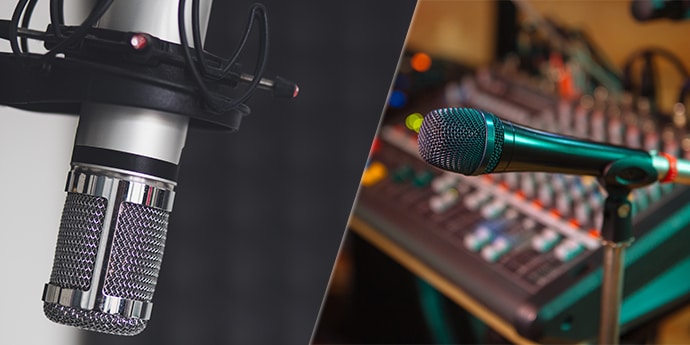You’ve probably heard producers and audio engineers refer to “dynamics” and “condensers.” These are two of the most commonly used microphones in home studio setups and professional recording studios. This blog post will discuss the differences and when you should pick one over the other.

How Do Microphones Work?
Before we check out the differences, let’s start by learning how microphones operate.
You see, this is where dynamics and condensers vary. Furthermore, their build and internal components give each mic its characteristics.
At its core, microphones convert sound waves into electrical signals.
They are made up of three main parts:
- Diaphragm
- Magnet
- Coil of wire.
The diaphragm is the thin membrane that vibrates when sound waves hit it. Around the diaphragm is a magnetic field caused by a magnet wrapped in wire. When the diaphragm vibrates, it moves the coil of wire back and forth through the magnetic field, which generates an electrical signal. This signal is amplified, then recorded or broadcasted.
What Is A Condenser Microphone?
To understand how a condenser microphone works, we first need to understand what a capacitor is.
A capacitor is an electrical component that stores energy in an electric field. It consists of two conductors, one fixed and one movable metal plate. The fixed plate is charged with high voltage, while the movable plate is connected to the audio signal. As the audio signal changes, the movable plate moves back and forth, changing the distance between the two plates. This shift in distance alters the capacitance between the plates, which changes the voltage across them. This changing voltage produces an electrical signal, which is amplified and sent to the mic’s output.
Advantages
Due to the thin membrane, condenser microphones are more sensitive than dynamic microphones.
So what does that mean?
They can pick up subtle sound nuances that would be missed with a dynamic mic. This makes them ideal for recording vocals and acoustic instruments.
Condenser microphones also have a broader frequency response than their dynamic counterparts, meaning they can capture both high and low frequencies well.
This makes them a good choice for capturing the full sound of an acoustic piano or acoustic guitar.
Disadvantages
One downside to condenser microphones is that they are more delicate than other microphones. They can be easily damaged by heat, humidity, or physical impact.
Additionally, they require phantom power, which means they need additional equipment to operate. Phantom power is provided through an audio interface, mixer, or preamp.
Another disadvantage of condenser microphones is that they tend to pick up more background noise than other microphones.
This can be a problem in live settings where a lot of ambient noise is present.
What Is A Dynamic Microphone?
Dynamic microphones use a more straightforward principle to convert sound waves into electrical signals.
Rather than using a capacitor, dynamic mics utilize electromagnetic induction to create the voltage.
Electromagnetic induction?
In short, it’s the process of generating an electric current using a magnetic field.
Inside the microphone, there is a small coil of wire. The metal coil is suspended in a magnetic field. When the mic picks up sound waves, the diaphragm causes the coil to move back and forth in the magnetic field.
This movement creates a small electrical current, which is amplified and sent to speakers or headphones so you can hear the sound.
Advantages
Dynamic microphones are known for their durability, affordability, and versatility. They can be used in various settings, including live concerts, conferences, and interviews.
They’re also less sensitive to background noise than other types of microphones.
However, the main benefit of using a dynamic microphone is that it can handle high sound levels (SPL) without distortion.
This makes them ideal for use in loud environments such as concerts or nightclubs.
Furthermore, dynamic microphones are also relatively inexpensive, which makes them a good choice for budget-conscious consumers.
Disadvantages
The disadvantages of dynamic microphones include their relatively low sensitivity and limited frequency response.
As mentioned above, dynamic microphones are not as sensitive as other microphones.
This can work to their advantage, but it also requires more sound pressure to produce an adequate signal. As a result, dynamic microphones are not well suited for capturing delicate sounds.
In addition, dynamic microphones have a limited frequency response. They tend to roll off the highs and lows, resulting in a less transparent sound than condenser mics.
Which One Should You Choose?
Vocal Recordings
Some of the best microphones for vocal recording are condensers.
Here’s why:
First, condenser mics can capture a broader range of frequencies and are more sensitive than their dynamic counterparts.
This is ideal for recording vocals, as it allows you to capture all the subtlety and nuance of your performance.
Additionally, condenser microphones tend to have a smoother, more natural sound than dynamic microphones. This makes them ideal for recording vocals, as they won’t color your performance.
Acoustic Instruments
For acoustic instruments, choose a condenser microphone.
Why?
They have a better frequency response than other types of microphones, making them ideal for capturing the subtle nuances of an acoustic instrument.
Again, condensers are more sensitive than other microphones, meaning they can pick up even the softest sounds. This is especially important when recording delicate acoustic instruments such as violins or pianos.
Drums
Drums are some of the loudest instruments in a band, and you should use a dynamic microphone when recording.
How come?
They’re designed to handle high SPLs. They can also be placed closer to the source without fear of distortion so that you can capture those powerful drum hits.
Amps
Most guitarists and bassists will tell you that the key to getting a good sound out of their amplifier is to use a dynamic microphone.
Like drums, amplifiers are potent sound sources with high sound pressure levels. Furthermore, the strong signal won’t blow the mic capsule.
Also, dynamic mics are rugged and can withstand being placed close to the amp’s speaker cone. This proximity allows for better sound captures and fewer bleed issues when recording multiple tracks simultaneously.









